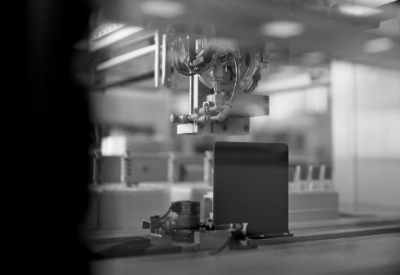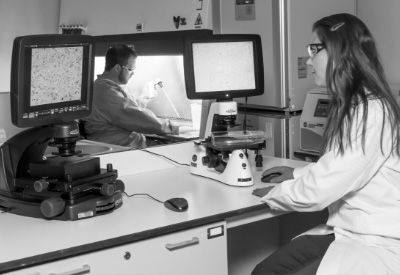November 2023 | News
How New Moon Exploration Technology Can Revolutionize Exploration
Space exploration has always been at the forefront of human ambition, driven by our insatiable curiosity about the cosmos. Despite it being the closest celestial body to Earth, humans have not set foot on the Moon since the Apollo 17 mission in 1972. Now, more than 50 years later, the United States has once again set its sights on returning humans to the Moon via NASA’s Artemis mission, with current plans for a human landing in 2025.
To propel human understanding of the universe to new heights, we must overcome various challenges, including radiation exposure, extreme temperatures, and the limitations of power sources. While Apollo mission technology was impressive for its time, we have made tremendous technological advancements since the 1960s and 1970s. We must come prepared with the most cutting-edge equipment to conduct meaningful science for humanity’s newest visit to the Moon.
The success of the Artemis mission is closely tied to our ability to conduct meaningful scientific analyses despite the existing lunar limitations and incentives for the development of new, robust microelectronic devices that can thrive on the cold and desolate lunar landscape.
City Labs, a pioneer in the field of microelectronic power, has introduced a groundbreaking solution in the form of NanoTritium™ batteries. These nuclear batteries are revolutionizing space exploration by offering unprecedented durability and longevity, making them the ideal choice for lunar and other interstellar missions.
Moon Exploration Facts and Challenges
The Moon, Earth’s closest celestial neighbor, has long fascinated humanity. In recent years, the lunar landscape has witnessed a resurgence in exploration efforts, particularly driven by NASA’s Artemis program.
This initiative seeks to establish a sustainable human presence on the Moon, utilizing the Moon as preparation for future missions to Mars as part of the “Moon to Mars” program. Due to the similar technological challenges involved in exploring both celestial bodies and their shared emphasis on the importance of dependable miniaturized, lightweight, and high-performance energy sources, we can anticipate a multitude of advantages stemming from technological advancements for the Artemis mission.
However, lunar exploration is not without its challenges. One of the most critical hurdles is the availability of reliable and long-lasting power sources to support the various scientific instruments and technological devices deployed on the Moon’s surface. This need for robust power solutions is further underscored by the fact that lunar nights can last up to two weeks, during which solar panels are rendered ineffective, leaving equipment entirely dependent on onboard power sources.
Previous Holdbacks in Space Technology
Historically, space technology has grappled with numerous obstacles, and the moon offers little in the way of protection. One of the most significant challenges is radiation exposure. Beyond Earth’s protective atmosphere, space objects are exposed to galactic cosmic radiation and single-event effects, which can cause irreversible and potentially catastrophic damage to electronic components. This exposure is why radiation-resistant devices are essential for long-term space missions.
Extreme temperature fluctuations also pose a problem. In the vacuum of space, temperatures can drop to a few degrees kelvin above absolute zero, affecting the performance of traditional power sources. Furthermore, space technology is often deployed to remote and inaccessible locations, where repairs or maintenance are impossible. This necessitates the development of equipment capable of withstanding the harsh space environment for extended periods.
In addition, electronic devices must be specifically designed to withstand the violent conditions that accompany launches, which subject onboard devices to intense vibrations that could damage circuit and battery components. The success of the Artemis mission will rest on addressing these challenges.
City Labs’ NanoTritium Batteries: Revolutionizing Space Power
City Labs’ NanoTritium™ batteries are poised to stand at the forefront of the space technology revolution. These batteries offer a unique and powerful solution to the challenges faced by space exploration.
NanoTritium™ batteries use tritium, a naturally occurring radioisotope of hydrogen, to provide a continuous power source. Unlike traditional batteries that rely on volatile chemical reactions that are adversely affected by temperatures at either extreme, NanoTritium™ batteries rely on the natural, steady decay of tritium to generate power, which occurs at the same rate regardless of temperature. These batteries, which incorporate betavoltaic technology, are not only predictable but also highly durable, even in the harshest of space conditions. Interestingly, tritium has already seen some application in space, as it was used to illuminate the glow-in-the-dark hands of the Omega Speedmaster wristwatches worn by astronauts Neil Armstrong and Buzz Aldrin during the first Moon landing.
Some of the notable advantages of NanoTritium™ batteries for lunar and space-based applications include:
Radiation Resistance
Radiation-hardened microelectronics are essential for any space mission, as exposure to radiation can lead to system malfunctions and irreversible damage. City Labs’ batteries are designed to withstand intense radiation, ensuring the long-term functionality of equipment in space.
Extreme Environment Tolerance
The extreme temperatures of space are no match for NanoTritium™ batteries. Able to operate in temperatures ranging from -55°C to 150°C, these batteries remain reliable in the most challenging conditions.
Longevity
City Labs’ NanoTritium™ batteries are built to last, with a continuous runtime of over 20 years. This extended lifespan ensures scientific missions and exploration efforts can continue uninterrupted.
Compact and Lightweight
These batteries are remarkably compact and lightweight, making them an ideal choice for microelectronics in space, where every gram of weight and inch of space matters.
Customizable
City Labs’ batteries can be tailor-made to meet the specific requirements of any application.
Industry Fueling Space Science
NASA recognizes the benefits and necessity of collaborating with outside experts, naming industry partnerships as “a cornerstone of humanity’s return to the moon under Artemis.” Toward this end, several companies have already been selected for Artemis-specific lunar science partnerships, aiming to contribute a variety of lunar-ready technologies ranging from 3D printing to surface mobility solutions.
As space exploration continues to evolve, it becomes increasingly evident that the demands of such endeavors span a wide spectrum of expertise, equipment, tools, and preparedness. Therefore, it is imperative for experts from diverse fields to collaborate to ensure the success and advancement of the Artemis mission, as well as future space travel endeavors. This interdisciplinary cooperation is key to pushing the boundaries of what’s possible in the realm of lunar exploration and beyond.
City Labs’ Collaboration With NASA
Recognizing the transformative potential of NanoTritium™ batteries, NASA has partnered with City Labs to develop a cutting-edge tritium-based power source for the next generation of microelectronic devices used in space-based applications. This collaboration is a significant step toward advancing space technology and expanding the possibilities of human exploration, whether it’s on the Moon or Mars.
This is not the only space-based technology application for NanoTritium™ batteries, with City Labs recently having partnered with the United States Air Force and Space Force to develop a nuclear ion engine for small satellites and self-powered wireless autonomous imaging sensors for satellites, respectively.
As NASA’s Artemis program and the broader Moon to Mars initiative gain momentum, the need for durable, long-lasting power sources becomes increasingly apparent. The technology developed in partnership with City Labs will play a pivotal role in achieving core science objectives during these missions.
These objectives include:
- Long-lasting surface power
- Crew mobility
- Surface communication
- Technologies to facilitate various tasks relative to lunar science efforts—including possible applications of NanoTritium™ batteries to power sensors used to detect potential supplies of water on the Moon
- Batteries on Mars (eventually)
A Bright Future for Lunar Exploration
Lunar exploration represents the pinnacle of human achievement, but it comes with its share of challenges. Although the Apollo mission revolutionized our understanding of the Moon and its history, there is still much to be discovered. The substantial advancements in technology since our last human-led expedition to the lunar surface will allow us to uncover even more discoveries.
To unlock the Moon’s mysteries and venture deeper into space, we must utilize innovative technologies capable of withstanding the extreme conditions present on the lunar surface. City Labs’ NanoTritium™ batteries are a game-changing solution, offering unparalleled radiation resistance, tolerance for extreme environments, exceptional longevity, and compactness.
As we continue to explore the Moon and beyond, these revolutionary batteries are poised to redefine the possibilities of space exploration, bringing us closer to realizing humanity’s age-old dream of setting foot on Mars—and perhaps even further beyond in future generations.










